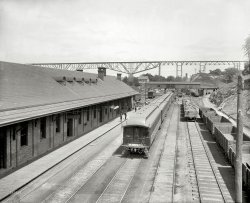
MAY CONTAIN NUTS

Search Shorpy
SHORPY ART

Framed or unframed, desk size to sofa size, printed by us in Arizona and Alabama since 2007. Explore now.
Join and Share
Ad-Free Shorpy
Shorpy is funded by you. Patreon contributors get an ad-free experience.
Learn more.

Recent comments
- Details, Details
- What's that building to the left of the tower?
- Coal Barges
- Bromo-Seltzer
- Inner harbor
- The Basin
- What a headache!
- Giant stepladder?
- Baldwin 62303
- Baldwin VO-1000
- Cold
- No expense spared
- Tough Guys
- Lost in Toyland
- And without gloves
- If I were a blindfolded time traveler
- Smoke Consumer Also Cooks
- Oh that stove!
- Possibly still there?
- What?!?
- $100 Reward
- Freeze Frame
- Texas Flyer wanted
- Just a Year Too Soon
- WWII -- Replacing men with women at the railroad crossing.
- Yes, Icing
- You kids drive me nuts!
- NOT An Easy Job
- I wonder
- Just add window boxes
Member Photos
The Shorpy
Print Emporium
Print Emporium
Search Shorpy
Search results -- 30 results per page
- Silver Springs: 1902
- ... of Palatka . 8x10 inch dry plate glass negative by William Henry Jackson, Detroit Publishing Company. View full size.
Unconcerned ... Posted by Dave - 07/31/2012 - 4:14pm -
![Silver Springs: 1902 Florida circa 1902. "At Silver Springs on the Ocklawaha." Our second look at the river steamer Metamora of Palatka. 8x10 inch dry plate glass negative by William Henry Jackson, Detroit Publishing Company. View full size.
UnconcernedNo one in this shot seems worried about the rope standing up on the bow by itself. I love this shot, you can almost smell the gators.
Not Long to LiveA sad end: "In the Silver River, near its confluence with the Oklawaha River, are the remains of the 1800's river steamer METAMORA, which sank March 19, 1903, with the loss of two lives (so it sank suddenly). "
The Metamora had a horizontal boiler like a railroad locomotive to keep her center of gravity very low.
The wreck is still visible and is a dive site:
http://www.treasuresites.com/members/cf.htm
Is That Bogie???That looks like the "African Queen" tied up along the dock.
Quite a ChangeFrom the dressed and top-hatted Tashmoo.
Period photosYou can almost always tell a period photo by looking for periods at the end more than one word grouping. Even names of store owners on their signs. Here we have Lucas New Line with a period at the end. Period periods.
Post-MetamortemThe Metamora's loss even came to the gummint's official attention.
Report of the Secretary of Commerce and Labor and Reports of Bureaus, 1904. Washington : Government Printing Office, 1905. p. 404.
Local District of Jacksonville, Fla.
1903.
March 19. — About 3.22 a. m. steamer Metamora suddenly sank in the Ocklawaha River, Florida, causing drowning of two members of crew (waiter and deck hand). Cause of sinking investigated, and licenses of Frederick E. Rossignol, chief engineer, suspended for 1 year, and of Frederick Priest, assistant engineer, revoked. Cases appealed and upon reexamination of matter by supervising Inspector, third district, decisions reversed and licenses restored to above parties.
They Must Have Been Tough I spent 12 miserable years in Florida and even with mosquito control, air conditioning and other modern conveniences, I would consider the state only partially fit for human habitation.
In 1902 the state must have been truly a hell on earth. I can't imagine how they did it.
[The passengers here are winter tourists. Not many full-time Florida residents back then. - Dave]
Upstanding bow line.That's a "sight pole" on the bow, used by the pilot (helmsman) to help gauge distance and degree on turns in tight quarters.
[Note that a not very successful attempt was made to retouch it out of the picture. - Dave]
Modern Navigation The fore pole allowed the captain to know where his bow was in relation to floating debris and snags, that bit of fuzz on the middle of the pole was probably a string of moss used to show wind direction, useful when docking or steering in tight spots, much like the pennants flown on sailing and steam ships.
(The Gallery, Boats & Bridges, Florida, W.H. Jackson)](https://www.shorpy.com/files/images/4a09437a.thumbnail.jpg)
- Saltair Pavilion: 1900
- ... version of Coney Island. 8x10 inch glass negative by William Henry Jackson, Detroit Publishing Co. View full size.
Saltair & ... Posted by Dave - 08/14/2012 - 12:33pm -
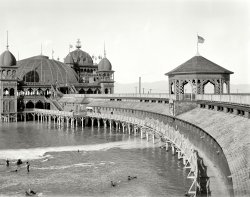
- Orleans Street: 1890
- ... near Cathedral of St. Louis." 5x7 inch glass negative by William Henry Jackson. View full size.
Getting the lay of the land Interesting ... Posted by Dave - 03/18/2019 - 12:48pm -
![Orleans Street: 1890 Circa 1890. "Street in New Orleans near Cathedral of St. Louis." 5x7 inch glass negative by William Henry Jackson. View full size.
Getting the lay of the landInteresting that Mr. Jackson didn't call out the name of the street in his caption. Maybe to prevent confusion?
Since the Cathedral faces the Mississippi across (Andrew) Jackson Square, you are seeing the back of it. The street that dead-ends behind the Cathedral is Orleans Street.
[As reflected by the title of this post! - Dave]
Sorry Dave, perhaps it was the absence of a pun-less title that threw me off. :^)
And the clock strikes ...High Noon.
French QuarterThis area of New Orleans is such a time capsule! It has hardly changed at all.
(The Gallery, DPC, New Orleans, W.H. Jackson)](https://www.shorpy.com/files/images/SHORPY-4a26979a.thumbnail.jpg)
- Light Lunch: 1902
- ... Register Co., Dayton, Ohio." 8x10 inch glass negative by William Henry Jackson. View full size.
It's a Matter of Perspective In ... Posted by Dave - 10/16/2015 - 10:37am -
![Light Lunch: 1902 Circa 1902. "Window in girls' restaurant, National Cash Register Co., Dayton, Ohio." 8x10 inch glass negative by William Henry Jackson. View full size.
It's a Matter of PerspectiveIn reality, the width of that window is a "normal" 36 inches. It just looks huge because the women are about 20 inches tall.
Having Worked ThereAt NCR during college here in Dayton, I can tell you, I got to know the history a little.
These girls were most likely office girls, or floor girls who worked in the compiling area (piecing together small parts that required delicate hands)but they were always nicely dressed. Patterson and Kettering were ahead of their time as far as employers of women.
Both men made it a company policy to make sure the women all wore uniformity clothing that was clean and attractive.
Some of my wife's relatives worked there and she always said what a great place it was to work in.
Patterson took care of his employees.
Girls Restaurant?I'm curious -- what is the "girls' restaurant"? Was it a restaurant at NCR reserved for women? I tried Googling for an answer but all I got was more references to this picture.
[Lunch room for women NCR employees. "Girls' restaurant" comes from the original Detroit Photographic Co. caption. -tterrace]
Dirty floorBut very clean table.
Immaculate LinensBut very messy floor.
An invitation for bugs and birds of all shapes and sizesThat is one huge sash window!
FamiliarJUST like our lunch room here at work, except for the nice china, the silver cutlery, the linen table cloth, the attractive service dishes, the plant on the table, the well-dressed staff. Oh, yeah, and the view out of the building. ANY view out of the building. Other than that, just the same.
IndeedVery light lunch indeed.
Having 2 sashes moving up and down verticallyThat is a huge double hung window.
Well lit light lunchThe girls in the picture are wearing aprons. They were probably restaurant staff recruited to pose for the picture. With a little skill, the final image can be rendered with an unsullied floor and NCR will have a model scene of the girls' restaurant.
(The Gallery, DPC, Eateries & Bars, W.H. Jackson)](https://www.shorpy.com/files/images/SHORPY-4a20580a.thumbnail.jpg)
- On the Street Where You Live: 1900
- ... was the residence of Detroit Publishing photographer William Henry Jackson. 8x10 inch glass negative. View full size.
Photomerge ... Posted by Dave - 08/15/2012 - 2:39pm -
![On the Street Where You Live: 1900 Detroit, Michigan, circa 1900. "W.H. Jackson residence." Just out of view across 2nd Avenue in this two-part panorama was the residence of Detroit Publishing photographer William Henry Jackson. 8x10 inch glass negative. View full size.
PhotomergeJust thought I'd run both of these through Photoshop's Photomerge command and see what the resulting panorama would look like.
[I tried the same thing (click below to enlarge). A passable result with a couple of obvious flaws -- the cable running across the street, instead of meeting in the middle, diverges at two very different angles, and the curbs on the left side of the street don't line up. Your version (bottom pic) turned out better, curbwise. UPDATE: I took another stab at it and came up with something a tad more Euclidean. Click to embiggen. - Dave]
Cass Park in the backgroundI think this picture is a view of 2nd Avenue heading away from downtown where it runs into Cass Park. I don't think any of these buildings still stand. And the park's fountain is sadly no more.
Nice rackFor bikes!
Fast ShadeAny idea of the address? I'd like to find out when this neighborhood was platted and developed, to get an idea of the age of the trees. Elms, besides having wonderful canopies, also are fast growers.
[Building on the left is the Marlborough apartments at 419-421 Second Avenue. (Addresses have been renumbered since this photo was made.) At the end of the street we can see the fountain in Cass Park. - Dave]
LocationThis looks like the street, from a 1895 Detroit street map.
(The Gallery, Detroit Photos, DPC, W.H. Jackson)](https://www.shorpy.com/files/images/4a20020a.thumbnail.jpg)
- Over and Under: 1900
- ... seeing more of, and whose progenitors carried DPC partner William Henry Jackson through Mexico and the American West in the 1880s and 1890s when ... Posted by Dave - 08/13/2013 - 3:44pm -
![Over and Under: 1900 Circa 1900. "Grade separation near Arlington, New Jersey." 8x10 inch dry plate glass negative, Detroit Publishing Company. View full size.
Transit SuperiorityTruly the two most romantic forms of travel man has ever created.
Classic 4-4-0That's about the most beautiful locomotive I've ever seen! They must have been burning special coal to have no visible smoke coming from the stack (bet it helped keep it clean too). By 1900, though, that classic layout was already considered obsolete.
You could probably see your reflection in the polished connecting rods and valve linkage.
Does anyone know what railroad this is? I can see lettering on the passenger car but can't quite read it even in HR. It isn't "PRR" (Pennsylvania, the one I remember from my NJ childhood).
[This is the Delaware, Lackawanna & Western locomotive seen earlier here. - Dave]
Two great looking wheelsand the cleanest steam locomotive on earth.
Howard Boulevard and Route 80I remember this from when I was a kid in the sixties. That's right by the back entrance to the Hercules powder plant. Today there is a park-and-ride.
Dressed to the ninesBoth the dapper looking youngsters and that gorgeous engine! The engine, quaint even by the standards of 1900, would look like it's going 100 MPH sitting still!
The GeneralA picture of the boys and their bikes would be interesting enough but this is an amazing picture. There's obviously something more interesting to look at than the camera or the train. The locomotive itself reminds me of Buster Keaton's "The General."
Road of AnthraciteThis is indeed the Delaware, Lackawanna and Western RR. The Lackawanna promoted its clean passenger service using "Hard coal, no cinders" with a creation of the ad guys known as Phoebe Snow.
A pretty lady was hired to be Miss Snow, and the campaign ran for many years before the Great War. A modern diesel powered streamliner placed in service after WWII was named "The Phoebe Snow" in honor of the original.
All of the fuss was about the DL&W burning lump anthracite, which didn't create cinders as soft coal did. The little American-type locomotive above has a long, narrow firebox [under the back end of the boiler and forward of the cab] which identifies the 128 as a lump burner.
These engines ran commuter trains from all over northern New Jersey to the Hoboken ferries at the turn of the last century. They had brief careers, however. They were replaced by larger engines that were demoted from mainline service by about 1910.
Hi-def look at the coach reveals a small "M&E" on the left end of the letterboard. This refers to the Morris and Essex Division. The coach also is lettered below the windows possibly indicating some sort of photographer's car.
[The car was the "Detroit Photographic Co. Special," which we'll be seeing more of, and whose progenitors carried DPC partner William Henry Jackson through Mexico and the American West in the 1880s and 1890s when he was exposing his "mammoth plates" -- 18x22 inch glass negatives taken by giant view cameras that were the Imax equivalent of the era, so massive they required a locomotive to haul around and develop. - Dave]
DPC SpecialThis special train was used by the Detroit Photographic Company to haul its photographers, equipment, and darkroom all over the country. The locomotives varied but the passenger car was specially fitted just for the company and as Dave noted, was owned by the Lackawanna. From what I understand, the DPC made at least two railroad excursion trips - one in 1899 and a second in 1902. Clearly they made other trips to gather photos that spanned several decades but the photo trains may have been more limited.
In quite a few other DPC photos you can see a locomotive pulling a single DPC passenger car somewhere in the distance. Before good roads and automobiles, the train was pretty much the only way to get anywhere that was more than a few miles away.
The photo below from the collection shows William Henry jackson sitting inside the DPC car.
Slick and sleekIt looks like this loco has been 'hot rodded'. Very slick indeed.
In three years that cycle on the left looks like it might have a Harley-Davidson motor slung into its frame.
Wonderful image, once again.
Dickson 4-4-0 Standard?
Railway and locomotive engineering, Vol. 8, 1895.
Equipment Notes
The Delaware, Lackawanna & Western have ordered two eight-wheel passenger engines from the Dickson Locomotive Works. They have received bids for 500 coal cars, and expect to award the contract this month. The road is very short of coal cars.
The pictured locomotive could be one of DL&W's Dickson Locomotive Works 4-4-0 Standard engines. Related photos on the web: here and here. The Lackawanna also owned several Dickson 4-4-0 Camelbacks but this photo is clearly not a camelback.
Straight skinny on the DL&W 128I had to go through my books and look this up.
The 19th century DL&W had the peculiar practice of having separate number series for each division.
Thus, our 128 was built by Dickson in 1876 with shop number 183, as DL&W Morris and Essex Div. no. 100 [During this period, she was named, logically enough, "Centennial"]. She weighed 87000 lbs in working order, and was renumbered in the general renumbering [1899, I think] to DL&W no.128. She was scrapped in 1909.
Detroit Photographic CarThe car may have changed depending on the railroad. The Denver Public Library has quite a collection of Detroit Photographic images as well, including these showing the car and a locomotive on the Chicago and North Western railroad.
http://digital.denverlibrary.org/u?/p15330coll21,8799
http://digital.denverlibrary.org/u?/p15330coll21,8796
The car is clearly a C&NW car.
Upgrading a bikeI noticed that the older boy has upscaled his bike to cool by flipping the handlebars over. Very racer looking.
(The Gallery, Bicycles, DPC, Kids, Railroads)](https://www.shorpy.com/files/images/4a07234a.thumbnail.jpg)
- Guard Your Cash: 1902
- ... near the center of the frame. 8x10 inch glass negative by William Henry Jackson, Detroit Publishing Company. View full size.
Tom ... Posted by Dave - 08/13/2012 - 6:56pm -
![Guard Your Cash: 1902 Dayton, Ohio, circa 1902. "Binding department, National Cash Register." Note the "Guard Your Cash" poster near the center of the frame. 8x10 inch glass negative by William Henry Jackson, Detroit Publishing Company. View full size.
Tom Terrific's SisterAnd she's wearing her thinking cap.
Guard Your CashWonder Woman circa 1902.
With a hatAt least four women at the front are involved in making those frilly crêpe paper-covered hat-like things: containers, apparently, but I can't figure the cash register angle.
Also, there's one in every crowd:
Re: Guard Your CashThat's an interesting skirt length - perfectly reasonable for today, but "interesting" for a heroine figure in 1902.
I can only imagine the crowd reaction if a girl actually wore that on the street back then.
[I believe the figure in the poster is supposed to represent an ancient warrior goddess, along the lines of a Wagnerian valkyrie. Which I suppose would catch some attention on the streets of Dayton even today. - tterrace]
Gibson GirlsRule!
ConnectionsLots of knob and tube wiring. At least they have a sprinkler system.
(The Gallery, DPC, Factories, W.H. Jackson)](https://www.shorpy.com/files/images/SHORPY_4a20575a.thumbnail.jpg)
- The Trees' Knees: 1897
- ... circa 1897. 8x10 inch dry plate glass negative by William Henry Jackson. View full size.
The cars -- the cars. Those cars ... Posted by Dave - 11/23/2017 - 4:22pm -
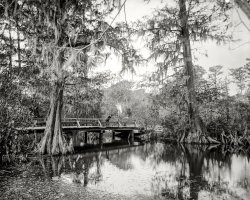
- Air Travel: 1902
- ... viaduct over Des Moines River." 8x10 glass negative by William Henry Jackson. View full size.
Thank Goodness it's not made from ... Posted by Dave - 07/17/2012 - 10:38pm -
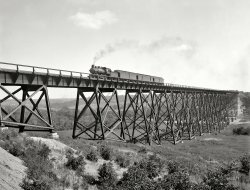
- Harlem River: 1890
- ... south. Circa 1890 albumen print from a photograph by William Henry Jackson. Detroit Publishing Co. View full size.
Graffiti on the ... Posted by Dave - 07/20/2012 - 1:33pm -
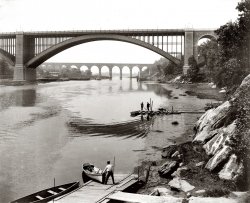
- Maritime Manhattan: 1898
- ... from the Washington Building." 5x7 inch glass negative by William Henry Jackson. View full size.
Toot, toot! Can you imagine the ... Posted by Dave - 12/18/2020 - 12:22pm -
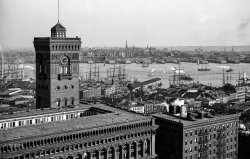
- Vicksburg Panorama: 1909
- ... View full size.
Panorama I know of one panorama William Henry Jackson composed for Leadville, CO, although I don't know if it was while ... Posted by Dave - 02/25/2014 - 11:33am -
![Vicksburg Panorama: 1909 The Mississippi River circa 1909. "Vicksburg waterfront." A panorama made from three 8x10 glass negatives (the widest image, pixel-wise, that Shorpy has ever posted -- be sure to scroll all the way over to the right). The nine-story skyscraper is the First National Bank. Detroit Publishing Company. View full size.
PanoramaI know of one panorama William Henry Jackson composed for Leadville, CO, although I don't know if it was while he worked for DPC. His "stitching" technique involved three large prints on easels, which he re-photographed. I found the process documented in a series of photos in the Denver Public Library.
Chinese groceryWhat a fascinating image. An unexpected surprise was the "Quong Yulin & Co." grocery, a few blocks away from "Sol. Fried" store.
Wikipedia currently lists Vicksburg at less than 1 percent Asian. Vicksburg's 165-year old Synagogue now has just 20 members.
I wonder how much of the construction along the waterfront is post-war. Vicksburg experienced quite a boom in population growth between 1860 and 1870.
Earlier components?I seem to recall parts of this (great) panorama as previous Shorpy photos. Can someone post links to them?
[One photo. Our Search box would take you here. Waiting in the wings, there is at least one other version of this scene taken the same day, for a total of three. - Dave]
Remarkable detailThis is a remarkable image. I wonder if Detroit Publishing produced any more of these stitched multi-image panoramas.
[Click the "Panoramas" link above the photo. The stitching is all done by me, and Photoshop. - Dave]
No Horseless CarriagesTypically photos of this vintage display horse & buggies AND early automobiles. Was Vicksburg behind the times or could it be the photo pre-dates 1909? Either way, this a facinating snapshot of a moment in time along the Mississippi River.
[The First National Bank building was completed in 1907. - Dave]
Seek and you shall findWay on the right, a Coca-Cola sign.
[Actually there are three. - Dave]
Very DirtyAn amazing photo. The thing I am thinking about is that all the ladies seem to be wearing long white dresses and the streets appear to be all dirt. Their clothing must have gotten filthy in a very short time from simply walking the streets. I am also loving the Steam Boat Exchange Saloon, I wonder what curious sights were beyond those doors ??
Merchants DespatchWell weathered.
Above the Falls Cityare buildings in disrepair, could they be civil war casualties?
[From 50 years earlier? That's fire damage. - Dave]
Coca-Cola and VicksburgVicksburg was home to the Biedenharn Candy Company, the first bottler of Coca-Cola. Although the drink was created in 1886, it was sold mainly at druggists and soda fountains. Biedenharn started bottling the drink in 1894.
Did the channel change?I notice from the satellite view that the channel fronting most of the city is now the Yazoo River, not that there is much of a waterfront left. Such a channel change is something that General U.S. Grant unsuccessfully tried to engineer in 1862-1863, but it looks like nature finally did what 19th Century military engineering could not, as nature always does.
Many of these buildings remainHaving lived in Vicksburg, I can tell you that while a number of the buildings shown along the Mississippi riverfront have been torn down and replaced, still, many of the buildings pictured in this panorama are still there, being re-purposed with new businesses and tenants through the years.
On Washington Street, the street the First National Bank building is on (still there, its main floor used still as a bank with professional offices on the other floors), many of these buildings still remain. You'll notice the many steeples and cupolas on the skyline.
Going from left to right, the first steeple is that of Christ Episcopal Church (still there); the two-storied brick building with the cupola right on the river (with train cars pictured in front) is the old L&N Railroad Depot, now a Visitor Center. Atop the hill, the building with columns on all sides and the cupola on top is the old Warren County Courthouse (built in the late 1850s), now the Old Courthouse Historical Museum. Right across the street from the Old Courthuse, you see the "steeple" of the City Jail. Past the First National Bank Building, going east up the hill is the tower of the Carroll Hotel (a picture of which was posted on Shorpy several years ago -- The Carroll was torn down sometime in the late '40s or early '50s).
The church that is pictured was St. Paul's Catholic, destroyed in the early 1950s when a tornado did a lot of damage as well as killing a number of people. A new church was built on the site in the 1950s. The squareish tower is the top of the Army Corps of Engineers headquarters, now used as the HQ of the Mississippi River Commission. The tall steeple at the left is Holy Trinity Episcopal Church. At the extreme left, the top two floors of the light-colored brick building (another skyscraper of five stories!) was a popular department store known as The Valley, which did business until sometime in the late 1970s or early '80s. The building has been converted into condos.
At this time, the downtown streets of Vicksburg were not dirt but were paved with brick. The streets going east, up the bluffs from the river were (and still are) paved with cobblestones in order that vehicles can get some traction going up and down. When I started driving as a teenager in the 1960s, I was told that if you could learn to drive on the hilly streets of Vicksburg -- in a car with a standard transmission -- you could drive anywhere!
Alice Used to be FrankThe sternwheel packet Alice B Miller, seen here to the right, was built in 1904 at Jefferson, Indiana, as the Frank B. Hayne. She became Alice in 1908 and met her demise by fire in Vicksburg in 1915. Source: University of Wisconsin LaCrosse, Murphy Library.
Superb, engrossing imageFascinating - rewards hours of scrutiny! Just wanted to say a sincere thank you for putting this one together and sharing it with us.
Depot at VicksburgThis view shows the Yazoo & Mississippi Valley Railroad (Y&MV) depot, not the L&N.
Great panos!Thanks for the link to the panoramas you've stitched. I now have to look forward to hours in the time machine.
(Panoramas, Boats & Bridges, DPC, Railroads, Vicksburg)](https://www.shorpy.com/files/images/SHORPY_Vicksburg_Panorama_4.thumbnail.jpg)
- The Long View: 1902
- ... "View from the Lodge on Mount Toxaway." Glass negative by William Henry Jackson, Detroit Publishing Co. View full size.
Sapphire The ... Posted by Dave - 08/20/2012 - 10:48am -
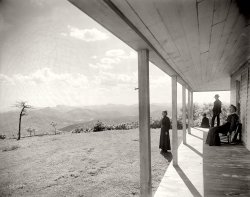
- Pennsylvania Avenue: 1902
- ... Woodward's trained seals. 8x10 inch glass negative by William Henry Jackson, Detroit Publishing Co. View full size.
One Automobile ... Posted by Dave - 08/09/2012 - 3:19pm -
![Pennsylvania Avenue: 1902 "Pennsylvania Avenue, Washington, 1902." Landmarks in this view from the Treasury steps at 15th Street include the Capitol and Old Post Office. On the bill at Chase's Polite Vaudeville: Capt. Woodward's trained seals. 8x10 inch glass negative by William Henry Jackson, Detroit Publishing Co. View full size.
One AutomobileOnly one automobile - and already they can't park for diddly!
Horse Car TrailersBy the mid-1890s Washington ordered conversion of horse cars to electric power. The last horse car ran in April of 1900. This view shows new electric cars pulling smaller horse cars as trailers, a common feature in early days of conversion to electric streetcars. Of interest is the new Washington streetcar system will use overhead trolley lines, as opposed to the earlier conduit system (underground power supply). DC even had a brief fling with cable cars.
[The "new" D.C. streetcar system used an underground power supply. -Dave]
Amazing!It is a PERPETUAL wonder to me that in these old pictures everyone seems to be in the streets (horses, people, buggies, trams-you name it) and they (seemingly) don't collide with each other. Clearly there were no monitoring police or crosswalks-how the heck did they manage it?
Willard's HotelVisible just down the street, on the left. Site of decades of political intrigue. Charles Templeton Strong famously said of Washington, "Beelzebub reigns there, and Willard's Hotel is his temple."
TankedWhat's the tank behind the horses on the left?
Dodge 'emkvenido mentioned all the street daredevils. A while back Dave posted a video of a film taken in San Francisco right before the 1906 earthquake. It was filmed from the front of a trolley, just one near hit after another.
We've seen pictures of the train that used to travel down Tenth Avenue in Manhattan. There were over 400 people killed by that train during the time it ran.
Life was cheap, I reckon.
A PossibilityMy guess for the tank? Either for road tar, or, probably more likely for that era, cesspool cleaning.
[Or water for street cleaning. - Dave]
That actually makes me think of another possibility (which I've learned from reading newspapers of that era), when some cities used water to get the dust to lay down during dry spells. However, given that the streets were predominantly paved in the area, washing seems to be the correct answer.
A nifty and oft-reproduced viewA survey of historic postcard views from this same location can be found here.
Not a Horse CarI suggest that streetcar 35 is not an old horse car, but rather an old cable car being used as a trailer behind the new electric car. The doorway in the dasher was to make it easier to change the grip. Today's San Francisco cable cars have the same feature, but the door is usually closed.
A look at nearly the same view, today.The clock-tower is still there, luckily enough.
Little else however; progress, I suppose.
View Larger Map
(The Gallery, D.C., DPC, Streetcars, W.H. Jackson)](https://www.shorpy.com/files/images/SHORPY_4a16820a.thumbnail.jpg)
- Army & Navy: 1903
- ... N.W., last seen here , was completed in 1891. Photo by William Henry Jackson. View full size.
Differences A lot of changes around ... Posted by Dave - 10/16/2021 - 7:21pm -
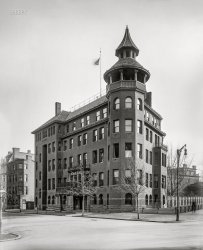
- Allegory: 1890
- ... "Tunnel 3, Tamasopo Canyon." Dry plate glass negative by William Henry Jackson, Detroit Publishing Co. View full size.
Passages ... Posted by Dave - 08/05/2012 - 3:09pm -
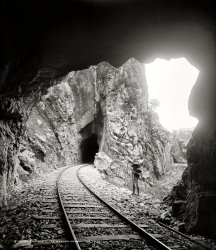
- Cobb Cottage: 1900
- ... Beach in 1896. 8x10 inch dry plate glass negative by William Henry Jackson. View full size.
Marine salvage In the photo ... Posted by Dave - 02/10/2016 - 10:34am -
![Cobb Cottage: 1900 Circa 1900. "Nathan Cobb house, a summer cottage, Ormond, Fla." A residence built from materials salvaged from the wrecked schooner Nathan F. Cobb, which capsized and ran aground off Ormond Beach in 1896. 8x10 inch dry plate glass negative by William Henry Jackson. View full size.
Marine salvageIn the photo accompanying this article, you can see the ship's nameplate that used to be on the outside of the house.
Shocking!The device on the pole to the right of center looks like an early radio or TV antenna until you realize it's 1900!
[Radio got its start in the 1890s, with wireless marine telegraphy being the main application. There are more wires going into the tree, and a similar looking mast on the roof with a wire going to it. - Dave]
RailingsThe front porch looks like it is utilizing the Schooner rails quite effectively
Great treehouseAnd the perfect spot to ambush passing travelers to relieve them of their goods.
Still thereBought recently to keep it from being destroyed; story here.
NoiseThat house is so close to the street. Traffic noise at night must have been awful. Actually, probably so quiet your own heartbeat keeps you awake.
(The Gallery, Boats & Bridges, DPC, W.H. Jackson)](https://www.shorpy.com/files/images/SHORPY-4a08772a.thumbnail.jpg)
- Royal Gorge: 1900
- ... Rio Grande Southern Railway." 8x10 glass negative by William Henry Jackson. View full size.
Royal Gorge RouteRailroad Today's ... Posted by Dave - 12/12/2013 - 12:23pm -
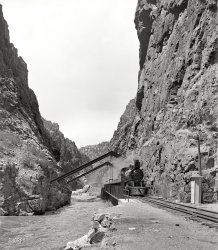
- Termite Terrace: 1901
- Miami circa 1901. "Hotel Royal Palm, west front." Henry Flagler's hostelry opened in 1897 and closed in 1930, condemned after a termite infestation. 8x10 inch glass negative by William Henry Jackson, Detroit Publishing Co. View full size.
Amazin ... Posted by Dave - 09/25/2014 - 5:37pm -
![Termite Terrace: 1901 Miami circa 1901. "Hotel Royal Palm, west front." Henry Flagler's hostelry opened in 1897 and closed in 1930, condemned after a termite infestation. 8x10 inch glass negative by William Henry Jackson, Detroit Publishing Co. View full size.
AmazinThat it didn't burn down before the termites got into it.
Current Issue of American Archaeology There is an article in the current American Archaeology Magazine on the the excavation of remnants of a Native American Tequesta village at this location. It probably escaped complete destruction in part due to being buried underneath the garden in front of this hotel.
To tterraceWas this the building where Looney Tunes were born?
[Well now, I wouldn't say that. -tterrace]
Let The Sun Shine InFlorida in the early 1900s, yet no window awnings? Wow, gotta love the heat to endure that. Then again I'm sure the hurricanes made short work of them.
[These hotels were winter destinations for their wealthy northern clientele. -tterrace]
(The Gallery, DPC, Florida, Miami, W.H. Jackson)](https://www.shorpy.com/files/images/SHORPY-4a08768a.thumbnail.jpg)
- Bull Street: 1901
- ... Georgia, circa 1901. "Bull Street." Glass negative by William Henry Jackson, Detroit Publishing Company. View full size.
BS is ... Posted by Dave - 07/19/2012 - 10:21pm -
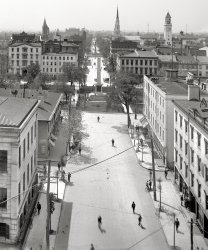
- Ponce de Leon Hotel: 1897
- ... Leon Hotel -- Front view and entrance." Railroad magnate Henry Flagler's coquina confection is known today as Flagler College. 5x8 glass negative by William Henry Jackson. View full size.
Still lovely What a beauty ... Posted by Dave - 04/10/2013 - 4:42pm -
![Ponce de Leon Hotel: 1897 St. Augustine, Florida, circa 1897. "Ponce de Leon Hotel -- Front view and entrance." Railroad magnate Henry Flagler's coquina confection is known today as Flagler College. 5x8 glass negative by William Henry Jackson. View full size.
Still lovelyWhat a beauty this hotel is and how nice to see that it is still there; it's enough to make me want to head over to St. Augustine ASAP!
Murals at the Ponce"The murals at the Ponce were well known at the time. Writing of a visit to St Augustine, Ring Lardner has one of his characters say:
"In the evenin' we strolled acrost the street to the Ponce—that's supposed to be even sweller yet than where we were stoppin' at. We walked all over the place without recognizin' nobody from our set. I finally warned the Missus that if we didn't duck back to our room I'd probably have a heart attack from excitement; but she'd read in her Florida guide that the decorations and pitchers was worth goin' miles to see, so we had to stand in front o' them for a couple hours and try to keep awake. Four or five o' them was thrillers, at that. Their names was Adventure, Discovery, Contest, and so on, but what they all should of [sic] been called was Lady Who Had Mislaid Her Clo'es.
The hotel's named after the fella that built it. He come from Spain and they say he was huntin' for some water that if he'd drunk it he'd feel young. I don't see myself how you could expect to feel young on water. But, anyway, he'd heard that this here kind o' water could be found in St. Augustine, and when he couldn't find it he went into the hotel business and got even with the United States by chargin' five dollars a day and up for a room"."
(Gullible's Travels - 1917)
Beautiful St. AugustineMy late midwestern-reared mother raved about this fair city the rest of her life, after having lived there from 1925-27 while my architect grandfather worked in the area creating hotels and civic building during Florida's pre-Depression land boom. His construction crew arrived one morning to find that all their tools had totally vanished at the bottom of a work site sinkhole, not there the previous afternoon, and inquisitive alligators were a recurring problem.
Flagler College/Ponce de Leon HotelI had the privilege of living in this beautiful building for four years, from 1976-1980, some of the best years of my life. I can see the windows of my freshman year and junior year rooms - the most unique college dorm you could ever find.
I collect lots of memorabilia from the hotel days, and was just back in St. Augustine this past January (2013) to celebrate the 125th anniversary of the opening of the Ponce de Leon Hotel. During this anniversary year the college has some great displays showing it's history over the years.
St. Augustine is a great place to visit, and this building and the campus should be a highlight of any visit.
125th AnniversaryHere is a picture showing the crowd of almost 4,000 people on January 12, 2013 attending the 125th anniversary event. The original opening ceremonies were re-enacted, complete with a trumpet fanfare from the towers, and a band on the loggia. Local dignitaries gave speeches, and a Henry Flagler re-enactor also spoke. The gates were then opened for a day long open house of the restored Hotel Ponce de Leon building. I was there for the 100th anniversary in 1988 and was lucky to also be there for this year's 125th.
St AugustineI loved going to St Augustine every weekend while I was working in Jacksonville FL and the hotel is truely a gorgeous place to see, along with all the other wonderful sights in St Augustine.
(The Gallery, DPC, Florida, W.H. Jackson)](https://www.shorpy.com/files/images/SHORPY_4a26939a.thumbnail.jpg)
- Tampa Pier: 1890s
- ... A house on the water. 5x7 inch dry plate glass negative by William Henry Jackson Detroit Publishing Co. View full size.
If it didn't ... Posted by Dave - 07/20/2012 - 1:40pm -
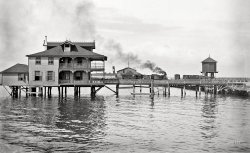
- Peeps and Pup: 1900
- ... relatives of photographer and Detroit Publishing partner William Henry Jackson -- possibly the family of his son Clarence. And a puppy of ... Posted by Dave - 07/09/2014 - 1:59pm -
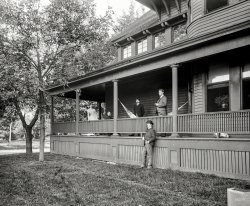
- All You Can Eat: 1894
- ... 1894. "Dining room, Hotel Royal Poinciana." At the time, Henry Flagler's giant hotel was the largest building in Florida. 8x10 inch glass negative by William Henry Jackson, Detroit Publishing Co. View full size.
Very ... Posted by Dave - 05/02/2015 - 6:02pm -
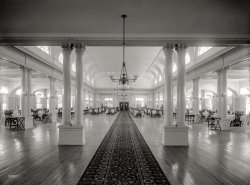
- Cash Stack: 1902
- ... Cash Register Co." 8x10 inch dry plate glass negative by William Henry Jackson. View full size.
Stack Jazz This image has the look ... Posted by Dave - 05/30/2017 - 9:46pm -
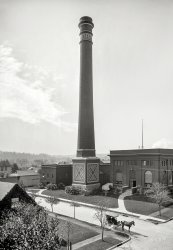
- The Cordova: 1891
- ... Hotel, St. Augustine." 8x10 dry-plate glass negative by William Henry Jackson. Detroit Publishing Company. View full size.
America with ... Posted by Dave - 08/13/2013 - 4:04pm -
![The Cordova: 1891 Florida circa 1891. "Cordova Hotel, St. Augustine." 8x10 dry-plate glass negative by William Henry Jackson. Detroit Publishing Company. View full size.
America with a few states lessBeautiful hotel complete with fountains, gardens and a 44 star American flag.
Casa MonicaNow the Casa Monica Hotel. Whose website has a nice history page.
View Larger Map
1891I've been in the coffee shop at the base of that tower many times. One of my favorite people watching places.
I would have guessed a little later then 1891. The safety bicycle and the men's boaters look more like 1901 to me.
[That 44-star flag would have been a tad out of date by then. - Dave]
Great placeI got engaged at the Casa Monica in 2000. It's hard to imagine living in Florida before AC.
(The Gallery, Bicycles, DPC, Florida, W.H. Jackson)](https://www.shorpy.com/files/images/4a03477a.thumbnail.jpg)
- Bien Venido: 1897
- ... "The Alcazar and Cordova from the Ponce de Leon." Three of Henry Flagler's landmark Florida hotels, with a welcome spelled out in Edison lights. 8x10 negative by William Henry Jackson. View full size.
Still looks lovely. I'll ... Posted by Dave - 07/18/2012 - 7:06pm -
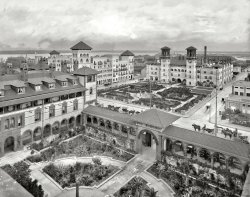
- Jax Landing: 1897
- ... Beresford on the St. Johns." 8x10 inch glass negative by William Henry Jackson. View full size.
Sidewheeler? Looks to me like a ... Posted by Dave - 05/11/2015 - 3:36pm -
![Jax Landing: 1897 Florida circa 1897. "Sidewheeler City of Jacksonville at Beresford on the St. Johns." 8x10 inch glass negative by William Henry Jackson. View full size.
Sidewheeler?Looks to me like a sternwheeler.
[Nevertheless, it's a sidewheeler. -tterrace]
Rather 'shortsighted' of me to overlook the back half of the boat.
Shingles?Are those roofing shingles on the dock?
Lake BeresfordIs about 130 miles South of downtown Jacksonville, near Deland. Photo from Lake Beresford Yacht Club dock.
Spanish mossI'm pretty sure what you thought was bundles of roof shingles was actually bales of Spanish moss. Between 1900 and the 30s Spanish moss was produced by southern states like Florida, Lousiana, etc. and shipped north to be used as stuffing and packing material and such.
Spanish moss afireJust such moss was the source of a fire that destroyed much of the city just 4 years after this picture was taken.
(The Gallery, Boats & Bridges, Florida, W.H. Jackson)](https://www.shorpy.com/files/images/SHORPY-4a03600a.thumbnail.jpg)
- Circle in the Sand: 1901
- ... Panorama made from two 8x10 inch glass negatives. Photo by William Henry Jackson. View full size.
Sand or snow Looks almost like Duluth ... Posted by Dave - 08/03/2021 - 12:33pm -
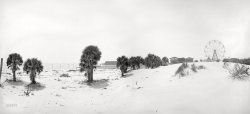
- Poughkeepsie Station: 1890s
- ... the Hudson River. 8x10 inch dry plate glass negative by William Henry Jackson, Detroit Publishing Company. View full size.
Poughkeepsie ... Posted by Dave - 03/24/2013 - 12:38pm -
